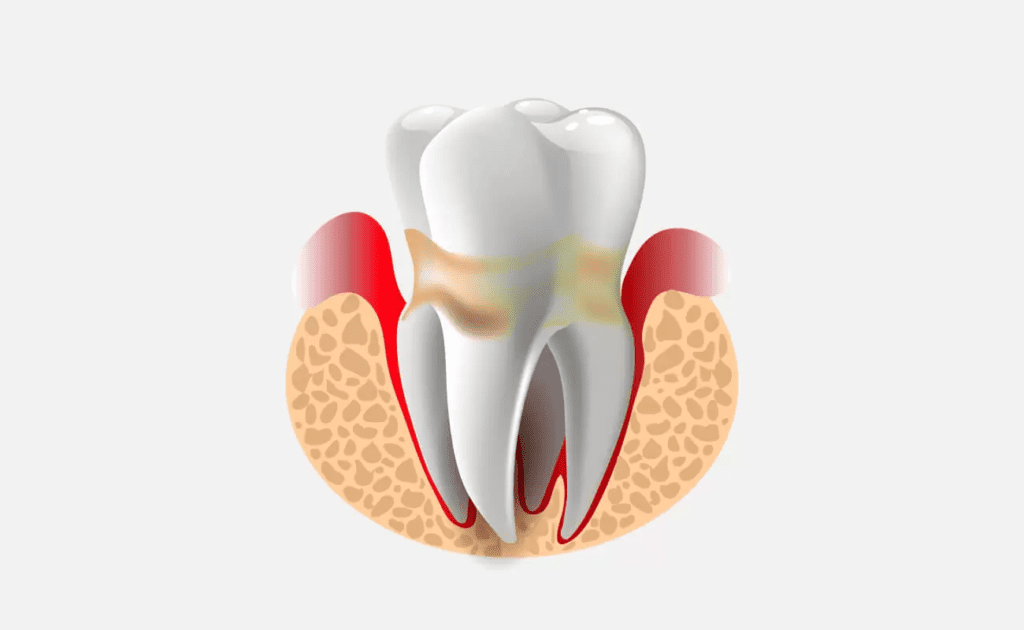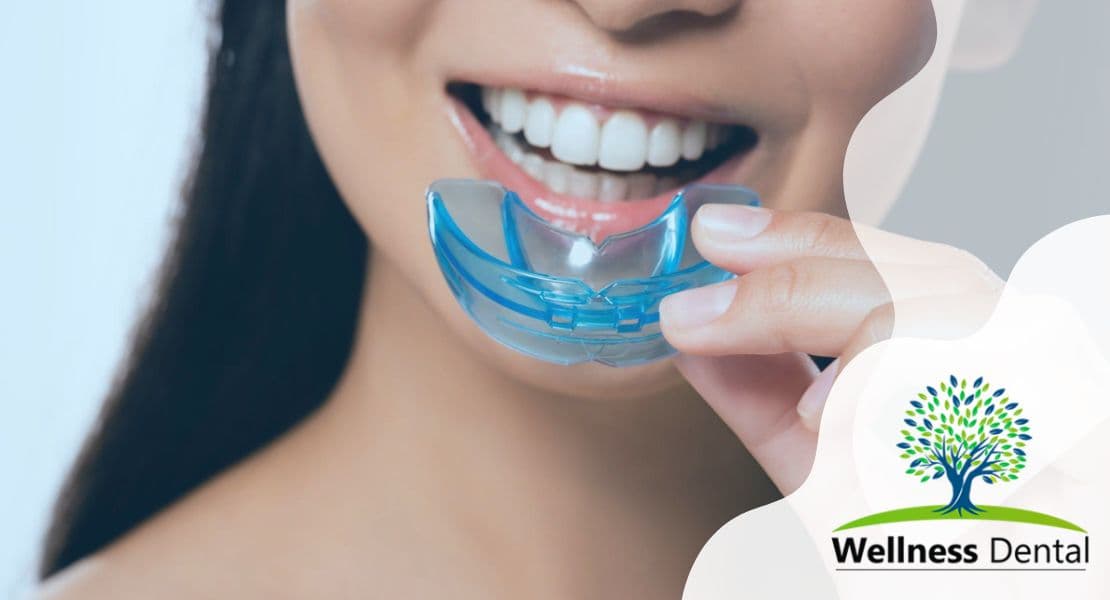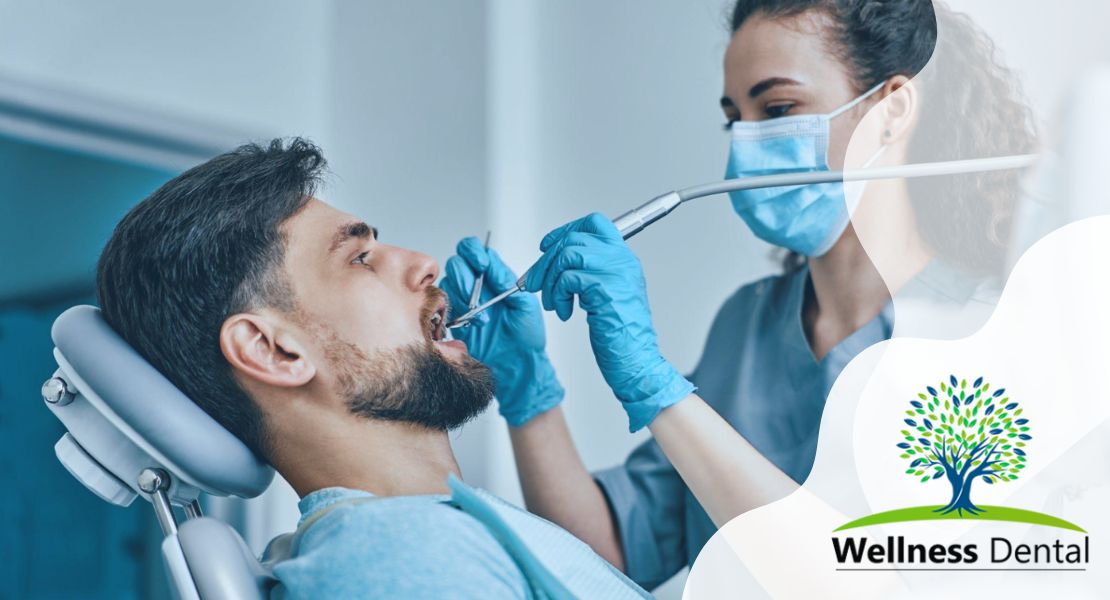What is gingivitis?

Gingivitis is a common and mild form of gum disease that causes irritation, redness, and swelling of the gingiva, which is the part of the gum around the base of the teeth. It is often caused by poor oral hygiene that allows plaque to build up on the teeth and gums.
Without proper treatment, gingivitis can lead to more serious gum disease and potential tooth loss. It is important to recognize the symptoms of gingivitis, such as bleeding gums, bad breath, and receding gums, to seek early treatment and prevent further oral health complications.
Symptoms
Gingivitis usually develops gradually and can be difficult to detect. Common signs and symptoms of gingivitis include:
- Red, swollen gums that bleed easily when brushing or flossing. This is usually the first sign of gingivitis.
- Bad breath that doesn’t go away even after brushing. This can be a sign of infection and inflammation in the gums.
- Receding gums, which make teeth look longer. As gums recede from the base of teeth, “pockets” form which can harbor more bacteria.
- Tenderness or pain in the gums. Inflamed gums can feel tender when touched or when eating hard foods.
- Pus around the teeth. Severe inflammation can lead to pus forming in the pockets around teeth.
- Loose or shifting teeth. As gum and bone tissue is destroyed, teeth can start to shift or feel loose.
- Change in bite alignment. Shifting teeth can alter how top and bottom teeth fit together when biting down.
- Tooth discoloration. As gums recede, more of the yellow-colored dentin beneath the enamel becomes visible.
The key is to catch gingivitis early and get professional cleaning and improved oral care to prevent it from progressing to more serious gum disease like periodontitis. See your dentist if you notice any of these symptoms.
Treatment
The treatment options for gingivitis and periodontitis include a range of interventions to address the various stages of gum disease. Good oral hygiene, including proper brushing and flossing, is crucial in preventing and managing these conditions. Professional dental cleaning, which involves removing plaque and tartar that builds up on the teeth and along the gumline, is essential for maintaining healthy gums.
In more advanced cases, scaling and root planing may be recommended to remove bacteria and calculus from the roots of the teeth. Ozone dental treatments can be used to kill bacteria and promote healing in the gums. Tissue grafts, bone grafting, guided tissue regeneration, and platelet-rich plasma are surgical procedures that can help restore damaged or lost gum and bone tissue.
In severe cases, the use of antibiotics may be necessary to control bacterial infection. Additionally, the pinhole surgical technique is a minimally invasive option for treating gum recession.
Individuals with gingivitis and periodontitis need to seek professional dental care to determine the most appropriate treatment plan for their specific condition. Regular dental check-ups and cleanings are crucial in preventing and managing gum disease.
What’s periodontitis?

Periodontitis, also known as gum disease, is a serious infection of the gums that can damage the soft tissue and destroy the bone that supports the teeth. It is caused by the buildup of plaque, a sticky film of bacteria that forms on the teeth. If left untreated, periodontitis can lead to tooth loss and other health complications. Understanding what periodontitis is and how to prevent and treat it is essential for maintaining good oral health.
Symptoms
Periodontitis, also known as gum disease, is characterized by a range of symptoms that become more severe as the condition progresses. In the early stages, symptoms may include red and swollen gums, bleeding gums, sensitive teeth, and sore gums. As the inflammation moves to the periodontium, the symptoms can worsen, leading to bad breath, loose teeth, and teeth that change positions. Additionally, individuals may experience pain during chewing and receding gums.
Periodontitis occurs in stages, and more severe symptoms are typically observed in later stages. The inflammation in the periodontium can cause the gums to pull away from the teeth, leading to pockets that become infected. This can result in the loss of bone and tissue supporting the teeth, eventually leading to loose teeth and changes in tooth position. Individuals with periodontitis may also experience increased sensitivity while eating due to the damage to the teeth and gums.
It’s important to seek treatment for periodontitis to prevent further damage and complications. Routine dental care and good oral hygiene can help prevent and manage gum disease.
Treatment
The various treatment options for gingivitis and periodontitis include oral hygiene measures such as regular brushing, flossing, and using antimicrobial mouthwashes to control plaque and bacteria buildup. Professional dental cleanings, which involve the removal of plaque and tartar, are also crucial in managing these conditions.
In some cases, antibiotics may be prescribed to manage bacterial infections associated with gingivitis and periodontitis. Open surgery, scaling, and root planing are other treatment options that involve the removal of plaque and tartar from deep pockets around the teeth and smoothing the root surfaces to promote healing.
Ozone dental treatments, tissue grafts, bone grafting, guided tissue regeneration, platelet-rich plasma, and the pinhole surgical technique are advanced treatment options for periodontitis that aim to regenerate lost gum and bone tissue.
It is essential to consult with a dentist or periodontist to determine the most effective treatment plan based on the severity of the condition. Overall, a combination of good oral hygiene practices, professional dental cleanings, and targeted interventions is key to managing gingivitis and periodontitis effectively.
What is the progression from gingivitis to periodontitis?
Gingivitis progresses to periodontitis in several steps. It begins with the accumulation of plaque on the teeth, which contains bacteria that release toxins. This leads to a chronic inflammatory response in the gums, causing redness, swelling, and tenderness. Over time, the inflammation damages the gum tissue and bone that support the teeth, leading to the formation of gum pockets. As the disease progresses, these pockets deepen, allowing more bacteria to accumulate and causing further damage. Ultimately, periodontitis can lead to the loosening and eventual loss of teeth.
The consequences of periodontitis can be severe, including tooth loss, gum recession, and potential systemic health effects such as an increased risk of heart disease and diabetes. It is essential to seek professional treatment for gingivitis to prevent its progression to periodontitis.
Regular dental cleanings and good oral hygiene can help remove plaque and prevent the buildup of harmful bacteria. If gingivitis is left untreated, it can develop into periodontitis, which is much more difficult to manage and can have serious consequences for oral and overall health. Seeking professional treatment for gingivitis is crucial in preventing its progression to periodontitis.
What are the risks of gingivitis and periodontitis?
The risks for gingivitis and periodontitis can be influenced by various factors, including smoking, genetics, stress, and certain medical conditions. Smoking can contribute to gum disease by weakening the immune system and making it harder for the body to fight off infection. Genetics plays a role in determining the strength of the immune system and the body’s ability to combat bacteria in the mouth. Stress can weaken the immune system, making it easier for gum disease to develop and progress. Certain medical conditions, such as diabetes and HIV, can also increase the risk for gum disease by compromising the body’s ability to fight off infection.
Hormone changes, medication, and nutrition can also impact the risk of gum disease. Fluctuations in hormone levels, such as during puberty, pregnancy, and menopause, can make the gums more susceptible to gingivitis. Certain medications, such as antihistamines and antidepressants, can cause dry mouth, which can lead to an increase in plaque and bacteria in the mouth. Poor nutrition can weaken the immune system and make it harder for the body to fight off gum disease.
Overall, these factors can contribute to the development and progression of gingivitis and periodontitis by weakening the immune system, increasing plaque and bacteria in the mouth, and making the gums more susceptible to infection.
What are the factors that contribute to gingivitis and periodontitis?
Gingivitis and periodontitis are primarily caused by plaque buildup, hormonal changes, medication side effects, and nutritional factors. Plaque buildup, which occurs from inadequate brushing and flossing, leads to bacterial growth and inflammation of the gums, resulting in gingivitis. If left untreated, gingivitis can progress to periodontitis, where the infection spreads to the surrounding tissues and bone.
Hormonal changes, such as those during pregnancy or menopause, can increase the risk of gingivitis due to heightened sensitivity to the bacteria in plaque. Certain medications, such as anticonvulsants and immunosuppressants, can also lead to gum inflammation as a side effect.
Nutritional factors play a role in gum disease as well, particularly deficiencies in Vitamin C and other nutrients necessary for gum health. Those with medical conditions such as diabetes, HIV, or cancer may be at an increased risk for gingivitis and periodontitis due to a compromised immune system. Additionally, lifestyle habits such as smoking can greatly exacerbate the risk of developing gum disease.
Overall, these factors contribute to the development and progression of gingivitis and periodontitis, emphasizing the importance of proper oral hygiene, regular dental visits, and a healthy lifestyle to reduce the risk of gum disease.
Ways to prevent gingivitis and periodontitis
Gingivitis and periodontitis are two common and preventable oral health conditions that can lead to serious dental problems if left untreated. By following simple steps and practicing good oral hygiene, you can significantly reduce your risk of developing these conditions.
By taking proactive measures, you can protect your gums and teeth from the damaging effects of these conditions and maintain a healthy smile for years to come.
Oral hygiene basics
To maintain good oral hygiene, it is important to follow a routine that includes several key steps. First and foremost, it is essential to brush your teeth at least twice a day with fluoride toothpaste. This helps to remove food particles and plaque that can lead to dental issues such as cavities and gum disease. Flossing between your teeth every day is also crucial, as it helps to remove plaque and food particles that your toothbrush may miss.
In addition to regular brushing and flossing, it is important to eat a balanced, nutritious diet that is low in sugar and acidic foods. These types of foods can contribute to tooth decay and other dental issues. Regular dental cleanings and check-ups are also an important part of maintaining good oral health. Dental professionals can remove plaque and tartar that regular brushing and flossing may not be able to reach, as well as identify and address any potential issues early on.
What are the methods of preventing gum disease?
Gum disease can be prevented by following a few key steps. Firstly, maintain good oral hygiene by brushing your teeth twice a day and flossing daily. This helps to remove plaque, which can lead to gum disease if left unchecked. Regular dental checkups are also essential for preventing gum disease. Dentists can identify any early signs of gum disease and provide professional cleanings to remove tartar buildup, which cannot be removed by regular brushing and flossing.
Additionally, avoiding smoking is crucial for preventing gum disease. Smoking can weaken the immune system and make it harder for the body to fight off gum infections. It also constricts blood flow to the gums, making them more susceptible to disease.
In conclusion, preventing gum disease requires a commitment to good oral hygiene, including daily brushing and flossing, regular dental checkups, and avoiding smoking. By taking these steps, you can significantly reduce your risk of developing gum disease and maintain a healthy, happy smile.






